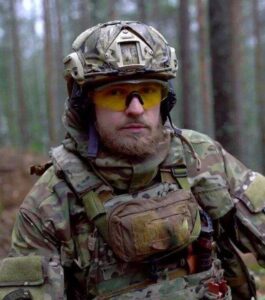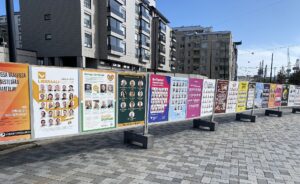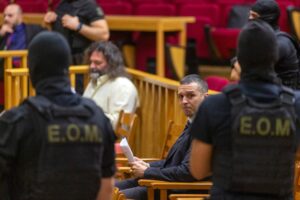This article is part 7 of 7 in the Hammerskins Series. This series was originally published in German via Exif – Recherche & Analyse, and gives us an in-depth look into one of the oldest and most stable neo-Nazi organisations worldwide. This final part of the series focuses on the failure of German intelligence services to identify Hammerskins as an influential actor within right-wing extremism in Germany and worldwide.
Part 1 of this series draws a larger picture of the network, its history, and its organisational infrastructure. Part 2 explains the identity of Hammerskins and its members, their rules and codes, as well as symbols and visuals they deploy. Part 3 gives a detailed account and explanation of their engagement in criminal activities, such as murder and terror attacks. All their activities are funded via multiple streams of revenue, which Part 4 analyses. Part 5 sheds light on the role of Hammerskins in the ‘NSU Complex’. Part 6 delves into the transnational aspect of the organisation and associated problems they face because of it. One central goal of this series is to drag Hammerskins workings out of the shadows and give possibility to the developing of counter-strategies, which so far seemingly has not happened.
In mid-June 2021, the Bundesamt für Verfassungsschutz (VS) [Federal Office for the Protection of the Constitution or BfV, Germany’s federal domestic secret service] presented its “Verfassungsschutzbericht” [“Annual Report on the Protection of the Constitution”] for the year 2020, accompanied by the usual media hullaballoo. Its 72 pages report on so-called right-wing extremism. And yet, there is no mention of the Hammerskins.
In the last ten years—despite the constantly expanding activities of the “Hammerskin Nation” (HSN) in Germany—the intelligence services have provided the public with hardly any information. It is a common misconception to think that the “Verfassungsschutzbericht” depicts a survey of so-called ‘anti-constitutional objectives/activities. On the contrary, the publication contains precisely what the Verfassungsschutz (VS) thinks the public should know.
What the VS deems confidential is kept brief or omitted entirely. Particularly since the revelations brought about by the efforts to elucidate the NSU-Complex, the official assessment of the fascist threat is rather worrying to many antifascists. Once again, the familiar questions demanding answers concern the issue of whose interests the different regional VS authorities follow, where they have placed their informants, how they wish to protect them and what risks they are willing to take in doing so.
Text blocks and a deafening silence
Germany’s domestic intelligence services most likely act in line with the political guidelines of their respective federal or regional governments, but the respective regional offices often pursue their own objectives and agendas. As a result, the regional offices and the federal office do not necessarily cooperate or take the same approach. This may lead to scenarios in which a given service may publicly disclose what another has intentionally sought to conceal. This is how the Saarland VS discusses the Hammerskins (HS) in its report for 2019: ‘Furthermore, the “Chapter Westwall” was also responsible for organising the HS “Sommercamp 2018”. The site of the camp, which was set up in early August, was located in a woodland in Eckmannsheim, Hesse, east of Gießen.’
The camp is not mentioned in the Hessian VS report. If the Hammerskins were referred to at least with a few standard phrases in the annual VS reports up until 2016, the HS are no longer mentioned at all from 2017 onward—although they had an influx of members in Hesse from the mid-2010s and produced their own compilation album in 2017.
Apparently, the federal VS office and regional VS offices simply use text blocks to inform the public about the HS, which are copied into new VS reports year after year and sporadically enriched with new data as needed.
Between 2013 and 2017, the regional VS in the state of Baden-Württemberg published the same identical text with a total volume of 550 characters each year without mentioning the existence of the HS chapters. In May 2013, its website stated: ‘In Baden-Württemberg, some right-wing extremist skinheads do maintain contact with the “Hammerskins”. However, a purported “chapter” (regional group) could not be identified yet.’ At the same time, a “Baden” chapter has existed since 2001 and a “Württemberg” chapter since 2009.
The Bavarian VS also always used the same text blocks in the 2010s. In its 2017 report, it surprised us all with additional information: ‘A meeting of 50 “Hammerskins” took place at a remote private property in Geiselhöring on 1 July. But: This “National Officers Meeting” (NOM) was made public by the “Antifaschistische Informations-, Dokumentations- und Archivstelle” [“Anti-fascist information, documentation and archive office” or A.I.D.A] in Munich.
The authorities obviously felt compelled by the Antifa publication to at least comment on this gathering. In the following reports, the VS returned to its empty phrases again.
In January 2018, a “European Officers Meeting” (EOM) took place in Triefenstein (Lower Franconia); in February 2019, more than 70 Hammerskins gathered at an EOM in Lohr on the Main (Lower Franconia)—neither of the two is mentioned in the VS report.
The Berlin VS reports from 2005 to 2009 repeatedly stated verbatim: ‘Due to insufficient organisational structures and the absence of an adequate leadership figure within their ranks, however, the “HS” were neither able to seriously compete with “Blood & Honour” nor assert their self-image as the elite of right-wing extremist skinheads. (…) In contrast to the claim made by the “Hammerskins”, the Berlin section lacks all and any outward profile.’
In the mid-2000s, the Berlin Hammerskins did indeed experience a profound crisis, but Benjamin D., a Hammerskin who had moved to Berlin from Mecklenburg-Western Pomerania, along with others, managed to rebuild the chapter.
Around the year 2010, the “Hammerskins Berlin” virtually absorbed part of the “Wolf’s Hook Brotherhood” group, which created new momentum. In the Berlin VS reports from 2010 to 2014, the Hammerskins feature only as an aside in the section “Netzwerk ‘Rechtsextremistische Musik’” [“‘Right-wing extremist music’ network”]. Since 2015, they have disappeared from the reports entirely.
By contrast, the 2018 VS report from Rhineland-Palatinate reads: ‘The “Hammerskin movement” is today considered one of the most important right-wing extremist networks worldwide. The international organisation, with its regional groups, and so-called chapters, who all enjoy equal rights, has branches in a number of countries around the globe. Public appearances by “Hammerskins” are very rare; they mostly operate covertly and do not indicate their political intentions outwardly either.’
The fact that there is the “Westwall” (formerly “Westmark”) chapter, the most influential chapter in the German-speaking world, with its focal point in the Ludwigshafen area, is not mentioned.
In the state of Saarland, the regional intelligence service devotes almost two pages to the “Westwall” chapter. In 2019, its report read: ‘The “Chapter Westwall” is also the home base of the current “European Secretary” of the HS. Although no official claim to leadership or power is attached to this office, the person who holds it is nevertheless highly respected and acts as spokesperson for the European Hammerskins vis-à-vis chapters outside Europe.’ This “European Secretary”, Malte Redeker, lives in Ludwigshafen.
The responses from the authorities concerning the Hammerskins in parliamentary inquiries and in the parliamentary NSU enquiry committees are similarly superficial. In response to an enquiry by the Left Party in 2018, in which it requested information from the federal government regarding “activities and structures of neo-Nazi “Hammerskins” in Germany“, the government presented more of an excuse rather than any meaningful information:
“The federal government cannot respond to the enquiries beyond these findings regarding HS for reasons of the public weal, as work methods, procedures and intelligence profiles are particularly sensitive with regard to future task fulfilment. The disclosure of detailed information concerning intelligence activities allows for conclusions to be drawn regarding the current focal areas of intelligence activities, the intelligence findings as well as aspects of police tactics and key investigation areas. After weighing the constitutionally guaranteed rights of the German federal parliament and its MPs to information against the negative consequences for the future working ability and task fulfilment of the constitution protection authorities as well as the resulting damage to the security of the Federal Republic of Germany, it follows that a response subject to VS classification, which may appear conceivable in the German federal parliament’s secret protection office, is also ruled out. In view of the constitutional principle of militant democracy, the federal government considers the information requested so sensitive that even a slight risk of it becoming known can under no circumstances be accepted.”
The 2012 killing of seven people at the Sikh Temple in Oak Creek, Wisconsin, US, by Wade Michael Page, a Hammerskin, is something which has been reviewed in many VS reports since 2012—but what has gone unmentioned by any German government authority so far are the close ties the murderer had to Germany. For instance, Malte Redeker and Hendrik Stiewe, in particular, maintained close personal contact with Page. They had met Page in the US on a trip during which a shooting training event was organised specially for the visiting German neo-Nazis. On a CD released in 2011, Page thanks Stiewe; both of them can be seen together in a photo. Stiewe lived in Bielefeld at that time and was connected to the Bremen chapter. He has not been mentioned in the VS reports from Bremen or North-Rhine Westphalia thus far.
Internal and external impact
The Saarland VS reports on a meeting in the “Hate Bar” clubhouse in Dillingen on 3 August 2019: ‘Due to the complaint from a resident about disturbance of the peace, an external impact could also be recorded for the first time.’ The persistent reference to an external impact—which is either achieved or not—illustrates the perspective from which authorities consider neo-Nazi concerts.
HSN concerts with 350 to 600 neo-Nazis took place in Würzburg each year between 2003 and 2005, generally perceived as the German “Hammerfest”. The 2004 concert took place in Kürnach in the barn of an agricultural property. The spokesperson for the Würzburg police told Bavarian TV that they could not break up the party because it had been declared a ‘private event’.
The journalist Thomas Kuban attended the concert undercover. In his book “Blut muss fließen” [“Blood must flow”], he reports on the concert with 600 attendees in a barn which was not soundproofed. Cries of ‘Sieg Heil’ echoed outside, and one band sang: ‘Punker, Schwule, Kommunisten steh’n auf unseren schwarzen Listen. Am Tage X, zur Stunde Null, da retten euch auch keine Bulln.’ [‘Punks, gays, communists are on our blacklists. On Day X, at zero hour, no fuzz will save you then either’].
In its report about the concert in 2004, the federal VS writes that the concert had had ‘no external impact’ and that ‘occasional “Hitler salutes” […] [had been] immediately suppressed by the security.” The fact that blatant terrorist propaganda had been delivered at this concert and calls to murder ‘punks and gays’ issued live on stage, in the presence of hundreds of people, was of little interest to Würzburg police because, as they explained, the attendees had kept “to themselves“.
The dissemination of ideological content via neo-Nazi rock music has contributed considerably to the radicalisation of tens of thousands of neo-Nazis, as well as leading to people being murdered, beaten up, tortured, threatened and expelled by neo-Nazis. This is the external impact, which inevitably follows the internal impact.
‘Unpolitical’ Hammerskins
In their official documents, the intelligence and security authorities usually describe the chapters as small groups that are elitist, act in a conspiratorial manner and pursue an ‘internal impact’. The HSN’s network is not mentioned. The various groups that are heavily influenced by the brotherhood and participate in the structure (e.g. music labels or meeting points) continue to be almost entirely ignored.
In the Berlin VS report for 2010 to 2014, the Hammerskins are mentioned just once: “In Berlin, in addition to several bands and songwriters, individuals and groups of people such as the “Hammerskins” and “Vandalen” [“Vandals”] are also active in the “right-wing extremist music” network, which operates in the environment of the bands and, above all, provide them with logistical support.” This is an interesting view.
On the one hand, the “brothers” are only mentioned in connection with a music network; on the other hand, it is concluded that they operate in the environment of the bands, while the possibility that the bands might be moving within the Hammerskins’ network is left unconsidered.
Regarding the HSN “Sommercamp” [“summer camp”] in August 2018 in Hesse, the VS Saarland writes that it was “largely of an unpolitical, casual nature.”
According to the authorities, the diagnosis of a ‘political nature’ can only be based on the discernible commitment to act politically. The underlying political understanding is outdated. It limits politics to that which explicitly claims to be political and to publicly visible actions. Without considering the supposedly unpolitical spheres of private and family life, it is impossible to comprehend members’ lifelong, private and political bond with and commitment to the HSN.
Why do authorities protect the Hammerskins?
In the wake of the post-investigations into the NSU-Complex, the Federal Criminal Police Office (BKA) published a report in January 2013 titled “HSN”, a document marked by reluctance and incompetence. It lists only four allegedly important chapters: ‘Sachsen’ [Saxony], ‘Bremen’, ‘Westmark’ and ‘Bayern’ [Bavaria]. Others, in turn, are missing: for example, the “Hammerskins Franken” [“Franconia Hammerskins”], who—as a result of their close connection with the neo-Nazi network “Freies Netz Süd” [“Free Network South”] and after organising and hosting the “Frankentage” [“Franconian gatherings”] earned themselves a name as a considerably more active group than the “Bayern Chapter”.
The report also mentions individuals who, according to the BKA, ‘maintain ties with the “Hammerskins” as members or sympathisers.’ As a result, neo-Nazis who were identified at (non-internal) HSN events are listed together with “full members” and “prospects”. No distinction is made.
Leading figures are missing from the list, names are misspelt, and individuals are matched with the wrong federal state. The report once again contains the assessment that ‘this network [is] sealed off to outsiders in the Federal Republic of Germany’ and expresses certainty that ‘with the exception of a small number of events, no greater public visibility [will develop] .’
Although reference to a “network” is made, this notion is then matched with an utter failure to analyse the corresponding structures adequately. The Hammerskins and “Blood & Honour” were originally supposed to be banned in Germany in September of 2000.
The Federal Ministry of the Interior was indeed considering a ban. Germany’s intelligence services—or rather the “V-Personen” [abbr. for Vertrauenspersonen, i.e. informants] whom they were paying—came to the conclusion, however, that there ‘is no “overarching association” of the Hammerskins in Germany’ and, consequently, a nationwide ban would be impossible.
According to the federal VS agency, ‘anti-constitutional objectives/activities’ can certainly be deduced from the publications produced by the Saxony (Hass Attacke—“Hate Attack”), Berlin (Wehrt Euch—“Defend yourself”) and Nordmark (Warhead) chapters, but evidence that the other “sections also appropriate the content of these fanzines, which are produced by other groups than their own, through new forms of conduct does not exist.”
This ignored (or prudently omitted) the fact that ever since 1996, so-called “European Officers Meetings” (EOM) have been taking place regularly, while a common set of common rules applying to all European chapters has existed from early on. “Blood & Honour” was unable to match this tight organisational model.
Furthermore, the authorities held the widespread view that a ban was counterproductive. The “Antifaschistisches Infoblatt” [or AIB, an anti-fascist publication in Berlin] described in 2016 why complex, years-long investigations of successor structures of the “Blood & Honour” network banned in Germany were rarely ever carried through: ‘Security authorities usually prioritise gaining profound insights into the structures, guided by the imperturbable faith that this will allow them to control these structures. […] Often enough, the swift conclusion of the investigation is the last thing authorities want, seeing as the surveillance measures then have to be discontinued or at least severely scaled back.’ Added to this is the fact that an indictment would frequently also (have to) compromise informants, as they are often at the top of the group hierarchies and heavily involved in criminal offences.
The authorities who “lead” these informants want to retain them as sources of information and therefore protect them. The message to the neo-Nazi scene is clear: cooperation with governmental bodies ensures the continued existence of groups and protects them from prosecution and punishment.
Indeed, there can be no doubt that police investigators value their access to information via paid informants in the neo-Nazi scene higher than any opportunity to break up organisations.
Protecting sources also takes precedence over protecting human life. Estimates of how many high-ranking and even leading neo-Nazis to work as informants or serve the security authorities as dialogue partners in some other capacity amount to 10 to 15 per cent. In the case of the Hammerskins, these informants, active around the year 2000, were the Saxony leader Mirko Hesse and (presumably) Steffen K., who still (or again) move within the scene today. But it can also take a different turn for informants: during the Thuringian committee of inquiry titled “Right-wing terrorism and government action” (in 2019), the testimony of a “V-Mann-Führer” [someone (i.e. a police or intelligence officer) who “leads”, or mentors, instructs, pays and keeps in touch with an informer] suggested, after being questioned by the Left Party MP Katharina König-Preuss, that the former Hammerskin Rene Weiße had also, for some time, worked as an informant for the intelligence services in Thuringia. This has resulted, more recently, in the scene turning its back on him while his band “Brainwash” has split up.
In the south, it was Karlsruhe-based Roland Sokol, an old guard of the southwestern German neo-Nazi skinhead scene who, at the age of almost 40—certainly in consultation with, and potentially even on the direct request of the regional VS agency in the state of Baden-Württemberg—joined the HSN. Sokol, the informant, was also directly involved in the development and organisation of the martial arts event “Ring der Nibelungen” [“Ring of the Nibelungs”], which, after being renamed “Kampf der Nibelungen” (KdN) [“Battle of the Nibelungs”], evolved into one of the pivotal structures in the neo-Nazi martial arts scene in Europe.
A crucial informant in the NSU-Complex also had ties to the HSN. Thomas Richter worked as an informant for the federal VS agency from 1994 until 2012 and was a supporter of “Crew 38” at the same time.
Several informants act in consultation with their group and sell only filtered information to their respective “service”. In return for this, they are protected from prosecution, and their organisations are left in peace. The results of this can be read in utter impositions like the “Verfassungsschutzbericht”, the annual domestic intelligence report.
In the wake of the NSU-Complex, Thuringia appears to be the only state to have learned its lesson from the intelligence disaster and has taken comprehensive measures to thoroughly abolish the so-called “V-Mann” system and set up an independent research institute instead. In all other federal states, the intelligence services have, despite all the scandals, emerged from the NSU-Complex stronger than before. They have been allocated more staff and, in many places, a budget that has almost doubled.
Conclusion
The facts are on the table: the Hammerskins are an international association that relies on permanent membership, a clear-cut and hierarchical organisational structure, a high profile, and extensive networks within the neo-Nazi scene. They share the same symbols, have their own statutes, can rely on a loyal and stable support network and promote a racist, anti-Semitic, national socialist worldview. Violence and terrorism are at the heart of their ideology. They make reference to terrorist strategies and glorify terror attacks, such as those of “The Order”.
Considering the relationship of the intelligence services with the Hammerskins, it is more than obvious that there is neither any intention of providing the public with accurate information nor of preventing any of the group’s activities—a classic example of the uselessness and dangerous role of the intelligence services and a reminder of the real threat which their modus operandi and the underlying reason of state pose to society.







